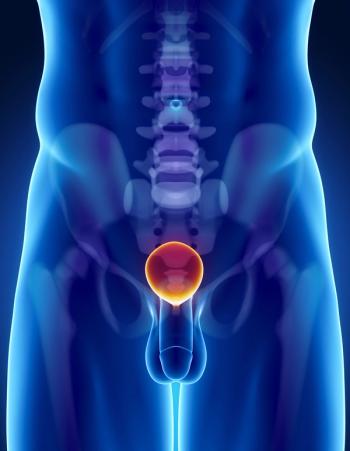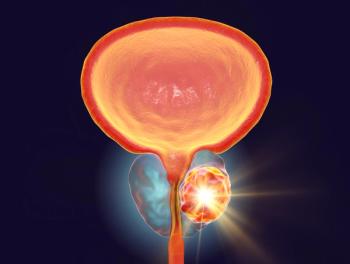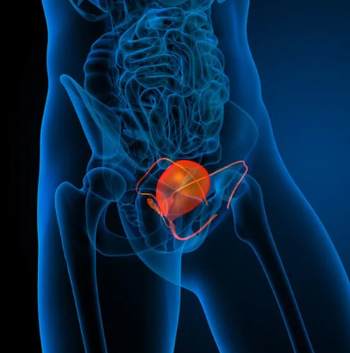
- ONCOLOGY Vol 10 No 4
- Volume 10
- Issue 4
Pathologic Evaluation of Prostatic Carcinoma: Critical Information for the Oncologist
Adenocarcinoma of the prostate is now the most common tumor in males. The use of the digital rectal examination, prostate-specific antigen (PSA), and transrectal ultrasound of the prostate with biopsies has improved the detection of prostate cancer and has increased the percentage of patients with organ-confined disease who are treated with radical prostatectomy. It is critical for the practicing urologic and medical oncologist to have accurate and precise pathologic information in order to counsel patients for appropriate therapy. Ideal biopsy and clinical predictive criteria for tumor volume in prostates are not readily available in the literature.
Adenocarcinoma of the prostate is now the most common tumor inmales. The use of the digital rectal examination, prostate-specificantigen (PSA), and transrectal ultrasound of the prostate withbiopsies has improved the detection of prostate cancer and hasincreased the percentage of patients with organ-confined diseasewho are treated with radical prostatectomy. It is critical forthe practicing urologic and medical oncologist to have accurateand precise pathologic information in order to counsel patientsfor appropriate therapy. Ideal biopsy and clinical predictivecriteria for tumor volume in prostates are not readily availablein the literature.
The ideal evaluation should probably separate patients whose tumorsare too small to be clinically significant from those requiringsurgery or other curative or palliative treatment. The percentageof tumor in biopsy specimens, ultrasound findings, and PSA densityhave all been used to stratify patients. However, Dr. Epsteinsummarizes studies that conclude, in general, that there is nostrict correlation between tumor size and extent of biopsy involvement,necessitating expert consultation in those cases for which a convincingdiagnosis of carcinoma cannot be reached. Since follow-up biopsiesmay be negative in such patients, there is a risk of underdiagnosis,especially given that many pathologists are uncomfortable makinga diagnosis of cancer based on one or two atypical glands.
Generally Accepted Prognostic Factors
In general, Dr. Epstein provides a thorough discussion of thegenerally accepted prognostic factors that may be obtained andreported by the pathologist. The histologic recognition of high-gradeprostatic intraepithelial neoplasia (PIN) is important becauseof the high degree of association with carcinoma. It is incumbentupon both the pathologist and oncologist to have a clear understandingof the definition and significance of high-grade PIN. Patientswith high-grade neoplasia need to have a repeat biopsy and verycareful follow-up. Previous studies have found carcinoma on repeatbiopsies in 30% to 50% of patients with high-grade PIN [1,2].
The most important of the prognostic factors is the Gleason sum,which, in some cases, may be underestimated due to limited tumoror failure to recognize a higher-grade pattern. The author makesan excellent point about the need to distinguish between the Gleasonsum and Gleason pattern. The pathologist should assign both aprimary and secondary pattern to avoid any confusion.
Evaluation of tumor ploidy is somewhat controversial and may notbe an independent predictor of tumor behavior. However, in theface of limited disease, an aneuploid tumor may indicate a worseprognosis and may suggest the need for more aggressive treatment.
In assessing the extent of tumor in radical prostatectomy specimens,pathologists need only approximate tumor volumes, as well as assesscapsular and seminal vesicle invasion. These staging parametersderived from whole-mount or quadrant sections are important featuresthat will assist the urologic and medical oncologist in makingdecisions about the need for postoperative radiation to the prostaticbed vs close observation with serial PSA values.
New Markers on the Horizon
There is an urgent need to identify new markers to predict thebiologic behavior of prostate cancer. Exciting laboratory workis being conducted looking at the extent of angiogenesis, thedegree of neuroendocrine expression, c-erB-2 (HER-2/neu), E-cadherin,and p53. These new markers and the pathologic criteria definedby Dr. Epstein will allow us to counsel our patients more appropriatelyregarding the various treatment options for prostate cancer.
References:
1. Weinstein M,H Epstein JI: Significance of high-grade prostaticintraepithelial neoplasia on needle biopsy. Hum Pathol 24:624,1993.
2. Brawer MK, Bigler SA, Sohlberg OE, et al: Significance of prostaticintraepithelial neoplasia on prostate needle biopsy. Urology 38:103,1991.
Articles in this issue
over 29 years ago
Radiosurgery Plus Sensitizer Tested for Brain Tumorsover 29 years ago
Regular NSAID Use Appears to Reduce Breast Cancer Severityover 29 years ago
Deaths from Melanoma--United States, 1973-1992over 29 years ago
Survivors of Childhood Cancer Face Other Medical Risks As Adultsover 29 years ago
Post-Transplantation Complications of Unrelated Bone Marrowover 29 years ago
Intensified VICE Regimen May Improve SCLC SurvivalNewsletter
Stay up to date on recent advances in the multidisciplinary approach to cancer.




















































































